Note: If an image ever fails to appear - refresh your page, it really is there
Flags of the American Civil War
| Flags of the North on this page | Flags of the South on this page |
| Chart of More Northern Regimental and Unit Flags | Chart of More Southern Regimental and Unit Flags |
| Chart of Irish Regiments and Units - Both North and South |
The North - The United States of America
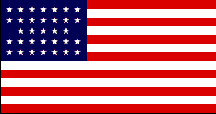
The 33-Star Flag
|
United States of America 1859-1861
The 33rd state to join the union was Oregon in 1859. This was our Flag for the next two years under Presidents James Buchanan (1857-1861) and Abraham Lincoln (1861-1865). At the outbreak of the Civil War (1861), President Lincoln refused to remove the stars representing those states which seceded from the Union.
|
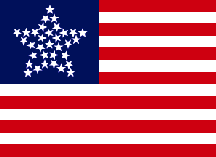
The 33-Star "Great Star" Flag
|
The 33-Star Great Star Design
Although never an official version of the United States flag, this very popular variant design was proudly displayed by many patriotic Americans. It was never officially used by the military or any government organization.
It should be noted here that Congress had never made any regulation about what type of star pattern should be used on the "official" United States flag. Therefore, any pattern was acceptable. The Navy regulated the star pattern on their "boat" flags to horizontal rows, but the Army and civil government did not. This explains the many different star patterns. |
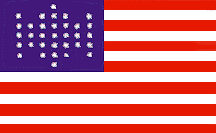
The Ft. Sumter Flag
|
The Fort Sumter Flag 1861
The 33-Star garrison flag that flew over Fort Sumter is sometimes called "the flag that started a war." The fort's commander was Major Anderson when the first shots of the American Civil War were fired in Charleston harbor. He surrendered to the Southern forces under General Beauregard after three days of token resistance. The only two casualties of the fighting were two Confederate privates killed when their cannon accidentally exploded.
Ever since the Mexican-American War (about 1845) the Army had followed an unofficial tradition of using a "diamond" pattern for the stars on their garrison flags. The Fort Sumter flag is a good example of this practice. |
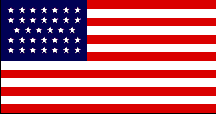
The 34-Star Flag
|
United States of America 1861-1863
In the first 3 months of the war a star was added when Kansas joined the Union in 1861. It remained our Flag for the next two years. President Abraham Lincoln (1861-1865) was the only President to serve under this flag as the Civil War raged.
|
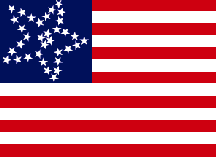
The 34-Star Flag
|
The 34-Star Great flower Design 1861-1863
The "Great Flower"" flag, also sometimes known as "The Candy Stripe"" flag because it sometimes had a red and white "candy stripe" (not shown here) running down the left side. Five asymmetric petal shapes loop out from the off-center heart of a graceful "Great Flower" pattern of thirty-four stars.
The flag designer, military units, or even the northern physical locations that this interesting flag design was used at are currently unclear. |
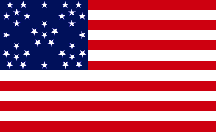
34-Star Flag
|
The 34-Star Cluster Design
This clever variant had five clusters of six stars each with the final four stars being centered on the top, sides and bottom. The five clusters of stars form a Saint Andrew's Cross and the four single stars form a Saint George's Cross. Because of this, this design was also called the "Great Cross" Flag. |

34-Star Round
|
United States of America 1861-1863
These national presentation colors were manufactured by the Evans & Hassall Company of Philadelphia for all the Union New Jersey regiments after 1863. |
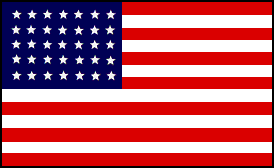
The 35-Star Flag
|
United States of America (1863-1865)
This flag became our flag when West Virginia separated from Virginia to join the Union in 1863. It remained our flag until the close of the Civil War. Presidents Abraham Lincoln (1861-1865) and Andrew Johnson (1865-1869) served under this flag. |
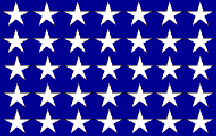
35-Star Union Naval Jack
|
The 35-Star Union Naval Jack
A jack is a flag that looks like the union or canton of a national flag or ensign. In the Union (United States) Navy, it is a blue flag containing a star for each state. For countries whose colors have no canton, the jack is simply a small national ensign. On a sailing vessel, the jack is hoisted on the jack-staff (flag pole) on a military vessel's bow (front end) when at anchor or in port. |
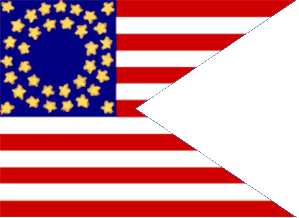
Union Cavalry Guidon
|
Union Mounted Troops Guidon 1862
This is the regulation 35-star cavalry guidon that was carried by Mounted Union Troops in the Civil War. The inner circle contains 12 stars, the outer circle includes 19 stars, and each corner includes a single star. It usually would be "customized" by placing a troop letter or other designator inside the circle of golden stars.
The U.S. Cavalry later used Stars and Stripe guidons in the Plains Indian Wars. In fact, the cavalry was the last of the three branches of service of the U.S. Army to carry the Stars and Stripes into battle. This was also one of the three flags that Colonel George A. Custer and the Seventh Cavalry carried at the Battle of Little Big Horn. |

General Custer's HQ Flag
|
General Custer's HQ Flag
In the Army of the Potomac, the Cavalry Corps used a swallow-tailed guidon with white crossed sabres centered over two horizontal stripes. The red over blue colors designated General George Armstrong Custer's headquarters. Custer was the youngest man given the rank of Major General in US military history, but when the US Army was downsized in 1866, Custer, because he lacked seniority and time in rank was temporarily reduced to his last permanent rank of Captain. Because of his outstanding war record, he was soon promoted up to Lt. Colonel and placed in command of the newly formed 7th Cavalry.
This image is a reasonably accurate stylization of the four guidons which General Custer carried during the war; all were red over blue with white crossed sabers, but all were different. Other versions can be seen on the Chart of More Northern Regimental and Unit Flags and on the Personal Guidons Chart of General George Armstrong Custer. |
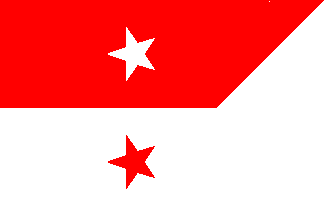
General Sheridan HQ Flag
|
General Sheridan HQ Flag
General Phil Sheridan's Army of the Shenandoah headquarters used this swallow-tailed guidon which was horizontally divided into a red over white striped field featuring two contrasting stars in the design. |
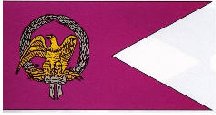
Army of the Potomac HQ Flag
|
Army of the Potomac HQ Flag
Major-General George Meade adopted this flag for the Army of the Potomac Headquarters. It was a swallow-tailed guidon featuring no strips, but with a golden colored eagle set within a silver wreath centered on a plain magenta field. |

General Ambrose Burnsides HQ Flag
|
Army of the Potomac HQ Flag
Before he commanded the Army of the Potomac, the badge, anchor and cannon devices were used on General Burnsides's swallow-tailed HQ flag of the Ninth Corps. When he took command of the whole Army of the Potomac his flag devices came with him. |

General Reynold's HQ Flag
|
Headquarters I Corps Guidon
According to General Orders 10 of the Army of the Potomac, all headquarters flags were changed to blue swallow-tailed guidons with white Maltese crosses and the corps number in red numerals in the center. John Fulton Reynolds was commander of the 1st Corps, Army of the Potomac. He was killed at Gettysburg on July 1, 1863. |
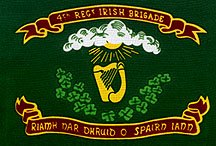
4th Infantry Regiment
Irish Brigade
|
The Irish Brigade
The 28th Massachusetts, designated the 4th regiment Irish Brigade, was commanded by General Meagher from 1861 until 1863. The unit's fame began at the first major engagement of the American Civil War. At the battle of Bull Run, the Union army was badly beaten and routed, but the Irish regiment had charged bravely and stubbornly held its ground. Even after its commander was wounded and captured, the Irish retreated in good order while panicked Union soldiers swarmed around them. Because of this, the "Irish" were usually placed in the center of the Union line and the rebels always knew when an attack was coming because the green flag with the golden harp of old Ireland was always at the head of every Union charge for the remainder of the war. |
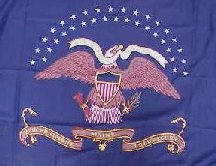
20th Maine Regiment Flag
|
20th Maine Regimental Flag
The 20th Maine was organized in the state of Maine in 1862. It became part of the 1st Division of the V Corps of the Army of the Potomac. The regiment served at Antietam, Fredericksburg, Chancellorsville, Gettysburg, Rappahannock Station, Mine Run, the Wilderness, Spotsylvania, North Anna, Totopotomoy and Bethesda Church, Cold Harbor, Petersburg, Five Forks, and Appomattox.
At the Battle of Gettysburg, the regiment under the command of Colonel Joshua Lawrence Chamberlain, was stationed on Little Round Top at the extreme left of the Union line. It was here that the regiment fought its most famous action. When the regiment came under heavy attack from the Confederate 15th Alabama, which was attempting to flank the Union position, and completely ran out of ammunition, it responded by charging downhill with fixed bayonets, empty rifles, and in desperate hand-to-hand combat ending the Confederate attack and turned the tide of the battle. This famous action is depicted in the novels "The Killer Angels," and "Courage on Little Round Top", and subsequently became an important scene in the movie "Gettysburg." |
| Flags of the North on this page | Flags of the South on this page |
| Chart of More Northern Regimental and Unit Flags | Chart of More Southern Regimental and Unit Flags |
| Chart of Irish Regiments and Units - Both North and South |
The South - The Confederate States of America
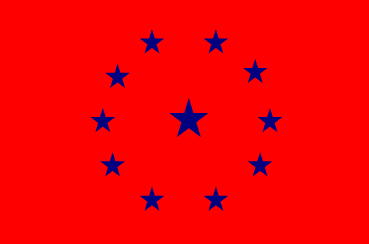
Proposed Confederate Flag
|
Proposed Confederate Independence Flag 1861
This flag was one that may have been proposed as a design for the Confederate States of America in 1861. The original of this flag was a flag formerly in the collection of Boleslaw & Marie-Louise d'Otrange-Mastai. It is illustrated, in their landmark book "The Stars and the Stripes," on page 136 wherein they identified it as the 1861 proposal for a flag of the new Confederate States of America. Its actual identification remains speculative, but the original flag was sold in 2002 at auction by Sotheby's as one of four pieces in a set for $7,768.00.
A modern replica version, in miniature and full size, identified as a Confederate Battle Ensign, was widely available during the American Revolution Bicentennial Celebration in 1975. It was made by a short-lived California flag company, the Golden State Flag Company, to celebrate the 200th anniversary of the United States. They were widely marketed through several grocery store chains, including Safeway and Pathmark.
|
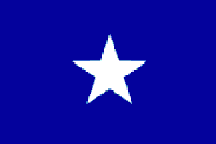
Republic of Mississippi Flag
|
The "Bonnie Blue" Flag
The first recorded use of the lone star flag dates back to 1810 when a troop of West Florida dragoons set out for the Spanish provincial capitol at Baton Rouge under this flag. They were joined by other republican forces and captured Baton Rouge, imprisoned the Spanish Governor and raised their Bonnie Blue flag over the Fort of Baton Rouge. Three days later the president of the West Florida Convention, signed a Declaration of Independence and the flag became the emblem of a short-lived new republic. By December the flag of the United States replaced the blue lone star flag after President Madison issued a proclamation declaring West Florida under the jurisdiction of the Governor of the Louisiana Territory. The lone star flag was used by the Republic of Texas from 1836 to 1839, and in 1861 became the first flag of the Confederacy.
The lone star flag was flown at the "Convention of the People" in Mississippi on January 9, 1861. It was later celebrated in the popular song "The Bonnie Blue Flag" (see lyrics) which was sung by southern troops on their way to battle. Although never officially one of the national flags of the Confederate States of America, it was considered one by the soldiers and southern people. The units from Louisiana and Texas adopted the Bonnie Blue as their official banner of the Confederacy. |
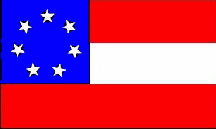
Stars and Bars (7 States)
|
First Confederate National Flag
(first version - March 4, 1861 to May 21, 1861)
This flag was adopted, but never officially enacted. In their haste to have a flag prepared for the flag raising ceremony on March 4, 1861, the Confederate Congress neglected to formally enact a flag law. When this flag was first raised over the capitol building in Montgomery, it contained seven stars, representing the Confederate States. This was also the flag used by the Confederate Army of the Potomac under General Beauregard at the First Battle of Bull Run (First Manassas) in 1861. This design was also used as the Confederate Naval Ensign between 1861-1863.
Strangely enough, one of the most persistent myths about Confederate flags concerns the First National flag. This myth states that this flag only saw combat at the First Battle of Bull Run, and was then replaced by the Army of Northern Virginia Battle flag (see below). In reality, of all the types of Confederate flags, this First National Flag (and its different versions) saw more battle service than any other and was still in use at the end of the war. |
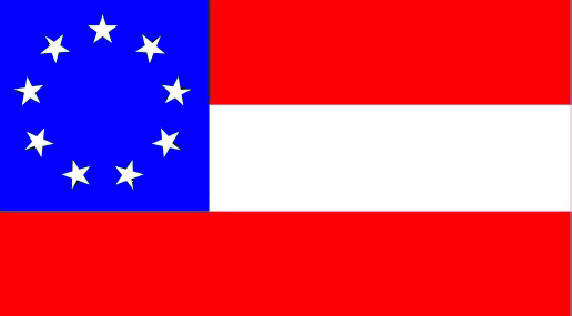
Stars and Bars (9 States)
|
First Confederate National Flag
(second version - May 21, 1861 to July 2, 1861)
By the third week of April of 1861 two more stars needed to be added to the First Confederate National flag representing Virginia and Arkansas. The official change happened on May 1, 1861 with the addition of these two stars to the blue canton of the flag.
In reality, there was really no "correct" version of these flag since they came in the late days of Jacksonian America, where most flags were hand-made, and people pretty much did what they wanted with making flags. |
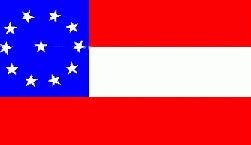
Stars and Bars (11 States)
|
First Confederate National Flag
(third version - July 2, 1861 to November 28, 1861) Much like the flag of the United States the Confederate States added stars as they added states. By May, North Carolina was added, and by June Tennessee had joined to increase the number to eleven.
The actual number of states to join the Confederacy was eleven, thus possibly making this flag the most correct, however, eventually 13 stars were added (see below).
|
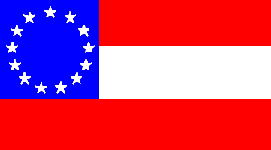
Stars and Bars (13 States)
|
First Confederate National Flag
(final version - November 28, 1861 to May 1, 1863)
The First National Flag eventually had 13 stars. The admission of Kentucky and Missouri in September and December brought the circle of stars to thirteen. During battle this flag was sometimes confused with the Union Stars and Stripes, therefore it was replaced by the 2nd National flag in 1863. Although there were only 11 states in the Confederacy, there were stars added for Missouri and Kentucky because both sides claimed these states. Missouri and Kentucky actually had two state governments: the elected governments which seceded and joined the Confederate States, and provisional governments created by the Union who actually held them.
In actuality, there were multiple versions of this flag. Examples on file include those with a single star as well as these star counts - 4, 7, 8, 9, 10, 11, 12, 13 , 15 and 17.
|
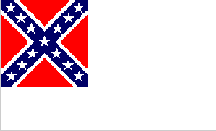
Second National Flag
|
Second Confederate National Flag
Although popular legend states that because the pattern and colors of the Stars and Bars flag did not distinguish it sharply from the Stars and Stripes of the Union, it sometimes led to confusion on the battlefield. So the legend states it was decided to design a new flag for the Confederate States that was in no way similar to the Union's Stars and Stripes. However, the real reason this flag was designed had nothing to do with the U.S. flag. It had more to do with the Confederate Congress seeking a more "Confederate" flag, to honor the battle flag of the Army of Northern Virginia, and to replace the First National Flag which had split feelings in the South.
Therefore, on May 1, 1863, a second design was adopted, using the "Southern Cross" Battle Flag as the canton on a simple white field. This second design was sometimes called "the Stainless Banner" and is sometimes referred to as the "Stonewall Jackson Flag" because its first use was to cover Stonewall Jackson's coffin at his funeral. The nickname "stainless" referred to the pure white field. This design was also used as the Confederate Naval Ensign between 1863-1865. |

Second National Flag
(possible variant)
|
Second Confederate National Flag (or regimental colors)
This interesting Second Confederate National Flag, with its reversed colors in the canton, was captured at the Battle of Paine's Cross Roads (Painesville) in Virginia near the end of the Civil War in 1865 by Sgt. John A. Davidsizer of the 1st Pennsylvania Cavalry. This action involved the burning of Confederate supply wagons at Painesville, Virginia, and seven Medals of Honor were awarded to Union soldiers as a result of this one action.
It should noted here that the Medal of Honor was routinely awarded for capturing the rebel flag during a Civil War battle, and the possibly exists that these units simply overtook the wagons and just plundered them for the flags before burning them, as this was not a pitched battle. It is even unclear if this flag is a variant Confederate national flag; or an unidentified regimental color. It is currently housed in the collection of the Museum of the Confederacy in Richmond, Virginia. |
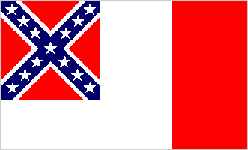
Third National Flag
|
Third Confederate National Flag
It was soon discovered that the Second Confederate National Flag (see above) was easily mistaken for either a white flag of surrender or parlay flag, especially when the air was calm and the flag hung limply, and it was decided that this flag also had to be modified. In 1865 it was officially replaced by this Third and last Confederate National flag which had a large vertical red stripe placed along its right edge.
Although not widely used because of the rapidly approaching end of the war, the flag was reported in Richmond newspapers in December of 1864 and by January of 1865, examples of this pattern were flying over Richmond hospitals and units of the James River Squadron. Some examples were also used as unit battle flags until the South surrendered on April 9th. |
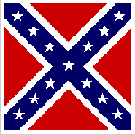
Army of Northern Virginia
Battle Flag
|
Army of Northern Virginia Battle Flag
Because the colors that different commands and regiments carried on the field were a major means of identification, local commanders designed special battle flags to distinguish units during battles. The most famous of these Confederate Battle flags was that of the Army of Northern Virginia.
The famous "Southern Cross" design was born when Southern Congressman William Miles suggested the design to General Beauregard, who took it to the army's commander General Johnston. The first battle flag was made in September of 1861 by Hettie, Jennie, and Constance Cary of Richmond. |

Army of the Peninsula
Battle Flag
|
Army of the Peninsula Battle Flag
The Confederate Army of the Peninsula was under the command of Confederate General John Magruder in the early days of the American Civil War, and it was General Magruder who ordered this flag made for his command in April of 1862.
The Army of the Peninsula fought against the invading Union Army of the Potomac, commanded by Union General John McClellan, from late 1861 until June of 1862 before being merged with the newly reorganized Confederate Army of Northern Virginia, now under the command of the legendary General Robert E. Lee. |
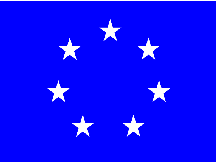
Naval Jack until 1863
|
Confederate States of America First Naval Jack
The First Confederate Navy Jack consisted of a circle of seven 5-pointed white stars on a field of light blue. Since a jack is a flag that looks like the union or canton of a national flag, the first Confederate Naval Jack was a blue flag containing seven stars just like the canton on the Stars and Bars. On a sailing vessel, the jack is hoisted on the jack-staff (flag pole) on a military vessel's bow (front end) when at anchor or in port.
|
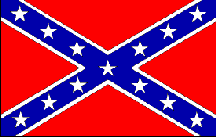
Naval Jack after 1863
|
The Second Confederate Navy Jack
The Second Naval Jack is basically a rectangular version of the "Southern Cross" as found on the canton of the Second Confederate National flag. The blue color in the saltire (the diagonal cross), however, is much lighter than on the national flag or the battle flag. It was flown by Confederate warships from 1863 to 1865.
After taking command of Confederate forces of the west in 1864, General Joseph Johnston modified the square Army of Virginia Battle flag for his Army of Tennessee, changing it to a rectangular shape similar to the Confederate Navy Jack. The attempt was met with disfavor by western commands who had fought under different flags earlier in the war. However, this rectangular flag later became the official flag of the United Confederate Veterans after the war, and today is mistakenly accepted as the "Confederate Flag." |
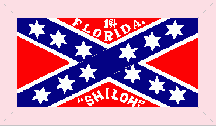
First Florida Volunteer Division - 1863
|
First Regiment of Florida Volunteer Infantry Flag
The 1st Florida Volunteer Infantry was organized at the Chattahoochee Arsenal during March of 1861. The unit fought long and hard throughout the war and was at nearly every major battle in which the Confederate Army of Tennessee was engaged. |
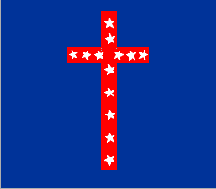
3rd Kentucky Mounted Infantry
|
3rd Kentucky Mounted Infantry Regiment Flag
The 3rd Kentucky Infantry was organized in 1861 in Tennessee. It was a part of Kentucky's "Orphan Brigade," until late 1862 when it was reassigned to the Army of Tennessee. Further research now shows that these flags were not just for the Orphan Brigade but, rather, were the battle flags of General John Breckinridge's whole division. Formerly, the Reserve Corps at Shiloh, it was the only command at the Battle of Shiloh without standardized battle flags and in May of 1862, the division adopted these flags and continued to use them into 1863.
The 3rd Regiment became mounted in 1864 and would serve in Mississippi, Georgia and Alabama. As a mounted regiment it was removed from the Army of Tennessee and remained to fight in Mississippi under Nathan Bedford Forrest. On May 4, 1865, what was left of the regiment surrendered at Meridian, Mississippi. |
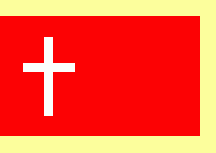
39th Georgia Brigade
|
Cummings' White Cross Battle Flag 1863
During the siege of Vicksburg, the Confederate volunteers from Georgia under the command of Brigadier General Alfred Cumming used this battle flag. It was one of the famous White Cross Battle Flags used by the Vicksburg Garrison in its struggle with the Union Army of the Tennessee of Union General U.S. Grant. This brigade was part of Carter Stevenson's Division, which probably all used similar flags, but only the flag of the 39th Georgia survives of this pattern.
The Confederate "Army of Tennessee" was named after the state, the Union "Army of the Tennessee" was named after the river, much to the confusion of history students ever since. |
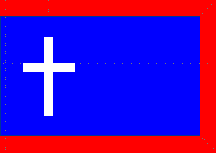
Missouri Raid Battle Flag
|
Bowen's White Cross Battle Flag 1863
General John Bowen's command established a distinguished combat record as a fighting division of the Army of the West at such places as Carthage, Wilson's Creek, Vicksburg, and Atlanta. According to legend General Bowen's wife smuggled in their first battle flag of this pattern into the Vicksburg siege. It had a blue field bordered in red and a white Latin cross set off-center toward the hoist edge.
The flag was used by all the brigades under Bowen's command. These flags first appeared in February of 1863. A later version was used by the troops of General Sterling Price's army in their 1864 Missouri raid.
|
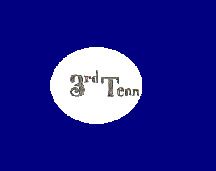
3rd Tennessee 1862
|
3rd Tennessee Hardee Battle Flag
The earliest western Confederate battle flag was flown in Hardee's Corps of the Army of Tennessee. It had been designed by General Simon B. Buckner and first issued to his troops in January of 1862, who were part of the Army of Central Kentucky based in Bowling Green. It first saw action at Ft. Donelson where some of Buckner's Division had been transferred. What remained of the army after this transfer became General William J. Hardee's Corps, which retained the flag.
It's simple design of a blue field and a white center became known as Hardee's Battle Flag. Each Unit's flag were soon inscribed with names of battles they fought in. Later versions had white borders all around. Because of the large number of Tennessee regiments using this flag design it is sometimes referred to as the "Tennessee Moon" flag. |

54th Georgia Volunteers
|
54th Georgia Infantry Volunteer Hardee Flag 1864
The 54th Georgia Infantry Volunteers were first formed in May of 1862. They were part of General Hugh Mercer's Brigade which had carried Charleston Depot battle flags as part of General William H.T. Walker's Division. Assigned to General Patrick Cleburne's Division in late July, 1864, the brigade finally received their Cleburne/Hardee battle flags after Atlanta's fall, just prior to the Tennessee Campaign.
By 1865, the Southern armies had taken so many casualties that they were consolidating units together to maintain their ability to fight. Two such units, the 4th Battalion Sharpshooters and the 37th Regiment Georgia Infantry were joined together with the 54th Georgia Volunteers Regiment in April of 1865 in North Carolina.
|
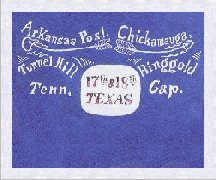
Combined Texas Division
|
Cleburne's Texas Cavalry (dismounted) Hardee Battle Flag 1864
In November of 1863, the 17th and 18th Texas received their new flannel Hardee flags inscribed with the battle honors of the previous campaigns: Arkansas Post, Chickamauga, Tunnel Hill, and Ringgold Gap. During the Atlanta Campaign, the units participated in some of the hardest fighting of the war. This is the flag of the combined 17th and 18th Texas, it was not issued to the regiment until sometime in early 1864, when the rest of Cleburne's Division got new battle flags.
On July 22, 1864, while fighting in the Confederate front lines, the 18 Texas became cut-off, and nearly surrounded, forcing the surrender of a large number of its men. After a brief hand-to-hand struggle, the battle flag was taken by Union General William T. Clark. After the war, veterans of the 18th Texas made considerable efforts to locate their flag, which in 1914 was returned to Texas by General Clark's widow. |

Hart's Battery 1863
Recent speculation has questioned this flags identity, suggesting that it may have belonged to Good's Battery instead. |
Hart’s Battery (Dallas Artillery) 1861-1862
(Second Arkansas Field Battery 1863)
The confusing history of Hart’s Battery started in northwest Arkansas and the Indian Territory where the artillery unit served as part of the Second Brigade of McCulloch’s Division during the winter of 1861-1862. At the two-day Battle of Pea Ridge (Elkhorn Tavern) on March 7-8, 1862, the Yankees captured two of the battery’s guns, along with its colors. For reasons that are still unclear, the battery was then disbanded "for shameful conduct in the presence of the enemy." Apparently cleared of the charges, the battery (or a new one using the same name) was reconstituted in late 1862, just in time to be part of another disaster.
Assigned to Colonel Robert R. Garland’s Texas Brigade at Fort Hindman (Arkansas Post), the battery was again captured with the rest of the garrison when Confederate forces surrendered on January 11, 1863. Although this surrender is also a subject of controversy, from all accounts, Hart’s Battery served their guns professionally and courageously during the siege. After being exchanged in April 1863, Hart's Battery (or a new one using the same name) was once again reconstituted, and possibly spent the remainder of the war in the Trans-Mississippi Army as part of the Second Arkansas Field Battery. There are few references to the name "Hart’s Battery" during the last year of the war.
|
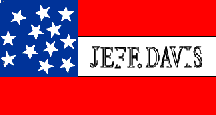
Jefferson Davis Flag
|
Arkansas Jeff Davis Flag 1862
This was a battle version of the First Confederate National Flag captured by Union forces at the Battle of Pea Ridge (Elk Horn Tavern) from an unidentified Arkansas brigade. It was made of wool flannel, with the words "Jeff. Davis" worked in black velvet letters.
At the Battle of Pea Ridge, two Confederate flags were taken from the forces of General McCulloch (see Hart's above). This was one of them. |
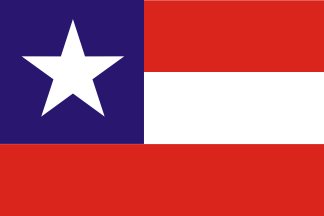
Hood's Texas Brigade Flag
|
Fifth Infantry Regiment, Texas Volunteers 1861
The Texas Brigade (Hood' Brigade) was an infantry brigade that distinguished itself for its fierce tenacity and fighting capability. The original Texas Brigade (1st, 4th, and 5th Texas regiments) was organized in 1861, and gained fame under its second commander John Bell Hood. The brigade fought in the Seven Days Battle, (Gaines' Mill), Second Manassas, Gettysburg (Devil's Den), Seven Pines, Seven Days Battle, South Mountain, Sharpsburg, Fredericksburg, The Wilderness, Chickamauga and during the Knoxville Campaign. Of the estimated 5,353 men who enlisted only 617 remained to surrender at Appomattox Court House in 1865. The Texas Brigade, along with the Stonewall Brigade from Virginia, were considered to be the main shock troops of the Army of Northern Virginia. For much of the war, the Brigade was assigned to Longstreet’s Corps.
The flag of Hood's Texas Brigade was a combination of the Confederate First National Flag and the Flag of the Republic of Texas. The Fifth Texas had great pride for the flag they called their "Lone-Star Flag." |
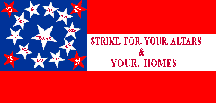
10th Texas Cavalry - 1862
|
The 10th Texas Cavalry Flag
As part of the Army of the West and later the Army of Tennessee, the 10th Texas was first organized in 1861 as cavalry, but dismounted in 1862, and fought the rest of the war as infantry. As part of McCown's Division they fought at Corinth, Vicksburg, Richmond, Jackson, Chickamauga, and Atlanta before surrendering at Citronelle, Alabama, on May 4, 1865. |
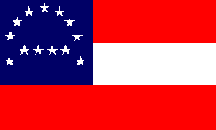
Lee's HQ Flag
|
General Lee's Headquarters (HQ) 1862-1863
General Lee's Headquarters flag, used between June of 1962 and the summer of 1863, has an unusual star arrangement that was believed to have been designed by his wife Mary to reflect the Biblical Arch of the Covenant. According to legend this flag was actually hand-made by Mary Custis and their daughters.
It is currently housed in the collection of the Museum of the Confederacy in Richmond, Virginia.
|
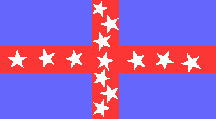
Polk Battle Flag 1862
|
The Polk Battle Flag
This was the first version of the famous Polk Battle Flag (13 stars). It was designed by Major-General Leonidas Polk for use by his "1st Grand Division" (corps) of the Army of the Mississippi. Polk had seen how Confederate troops using the CSA First National Flag (the Stars and Bars) could, because of its similarity to the Stars and Stripes, become confused on the battlefield, and decided to design his own that would not be mistaken for an Union flag. This flag saw action from Shiloh through the final surrender of the Army of Tennessee. The red St. George's cross was the symbol of the Episcopal Church. Polk was the Bishop of Louisiana. |
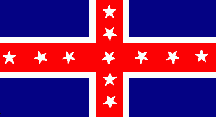
16th Tennessee 1862
|
16th Tennessee Volunteer Infantry Regiment Polk flag
This unit fought at most of the major battles of the Army of Tennessee including Corinth,
Mumfordsville, Perryville, Murfreesboro, Chickamauga, Chattanooga, Missionary Ridge, Franklin, and Nashville. They surrendered to Union forces at Bennett Farm, which today is the City of Durham in Durham County, North Carolina.
They used a second version of the Polk Battle Flag, issued in the summer of 1862, which had a cross edged with white and only 11 stars. The Polk Battle Flag continued in service through 1863. |
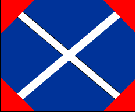
39th North Carolina 1863
|
McCown Battle Flag
Major-General John P. McCown was appointed to command of a division of the Confederate Army of the West in March of 1862. His troops, organized in two brigades, came from Texas and Arkansas. McCown was of Scottish descent, which probably explains the design of his battle flag for his division: Scotland's Cross of St. Andrew, a white saltire on a blue field.
This particular flag is that of the 39th North Carolina. The other remaining flags of this pattern have no red corners. This flag was probably issued to the Army of Kentucky in addition to McCown's Division.
|

Van Dorn Flag 1862
|
4th Missouri Infantry Regiment
When General Earl Van Dorn was assigned a Corps in the Army of the West in the trans-Mississippi theater, he personally designed this type flag for his command. Known as a "Van Dorn flag," it saw use until after the fall of Vicksburg in the west.
When General Van Dorn became Commander of the Army of the West in 1862 his flag came with him. Arriving too late to fight at Shiloh, Van Dorn's troops began adopting this flag in June, with the first issues (with slightly different star pattern and fringed edges) going to the Missouri Brigade. In August, the rest of the army received these flags which first saw use at Iuka and Corinth where some examples were captured. The crescent is taken from the Missouri state Coat of Arms was was designed to inspire Missouri troops as they crossed east of the Mississippi River. |

Cherokee Mounted Rifles
|
Second Cherokee Mounted Rifles 1862
This flag was first presented to Chief John Ross by Commissioner Albert Pike in 1861, and in 1862 became the first national flag ever carried by Cherokee troops in combat under the command of Colonel Stand Watie, a Cherokee Indian himself. It also began a military career that eventual allowed Watie to became one of only two native Americans on either side to ever become a general. His light calvary command participated in 27 major engagements and numerous smaller skirmishes. Most of their activities utilized guerrilla warfare tactics and Watie's men launched raids throughout the northern-held Indian Territory, Kansas and Missouri. He is credited with tying down thousands of Union troops. Watie was promoted to brigadier general in 1864. On June 23, 1865, he became the last Confederate general to surrender at the end of the war.
This flag still exists and is part of a collection of Confederate flags located at the Wilson's Creek National Battlefield Visitors Center located near Springfield, Missouri.
|

Choctaw Brigade Flag
|
1st Choctaw Battalion Cavalry 1863
About 200 Choctaw braves enlisted in the Confederate service early in 1863, under the command of Major Pearce, and soon afterward found themselves in a disastrous engagement with Union soldiers at Tangipahoe. They flew this distinct banner which features the native weapons of the Choctaw tribe. Many of the Indians and several of the white officers were captured at the battle and some of the Indians were taken North and put on exhibition. This put an end to the battalion as a formal organization, but some of the Choctaws later became dismounted scouts in Spann's Battalion of Independent Scouts. |

Annie Fickle´s Flag

Quantrill´s Raiders
modern fantasty flag
|
Quantrill´s Raiders 1862-1865
Quantrill´s Raiders were a loosely organized force of Confederate raiders who fought in the American Civil War under the leadership of William Clarke Quantrill. He and his men ambushed Union patrols and supply convoys, seized the mail, and occasionally struck towns on either side of the Kansas-Missouri border. The name "Quantrill´s Raiders" seems to have been attached to them long after the war, when the veterans would hold reunions. The same thing can be said about their flag.
According to local legend, Annie Fickle of Lafayette County presented a battle flag to Quantrill´s men in thanks for helping her get out of a Yankee prison where she was being held for aiding the enemy. In red letters, she stitched the name "Quantrell," a misspelling, on a plain black flag. The raiders appreciated her gift and carried the standard into several battles. Although Quantrill was killed in Kentucky in 1865, his "legacy" would live on, when many of his men continued on as outlaws after the Civil War.
One example would be that of Frank James and the "James-Younger Gang," including, of course, the infamous and often "Robin Hoodish" legends of Jesse James. |

Bath County Volunteers
|
Bath County Volunteers (Virginia) 1861-65
This is a company battle flag for a company of Confederate infantry raised in Bath County, Virginia. It saw service all through the war, and which was presented by the ladies of Bath County.
The flag is made of fine blue silk with a series of ornate, white scrolls in the center. At the top of the flag it reads "Presented by the Ladies of Bath," and at the bottom reads "God Protect the Right." |
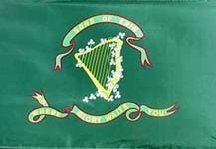
10th Tennessee Flag
|
10th Tennessee Irish Infantry Brigade
The unlucky 10th Tennessee Infantry was organized in 1861, just a few weeks after the first shot was fired at Fort Sumpter. The "Sons of Erin's" motto was "Go where Glory Waits You." At the fighting at Fort Donelson the 10th Tennessee suffered severe losses and earned the nickname of "The Bloody Tenth." After the surrender of Fort Donelson, the field and staff officers were taken as prisoners of war, moved to Fort Warren and Camp Douglas where they received cruel treatment, but were eventually exchanged in 1862. The reunited 10th Brigade was then ordered to Vicksburg where they suffered another bloody defeat at the Battle of Chickasaw Bayou. They continued to fight for the losing cause until the end of the war. There were less than 100 men left in the 10th Tennessee Infantry at the closing of the war, and every one of them had been wounded, many times. |
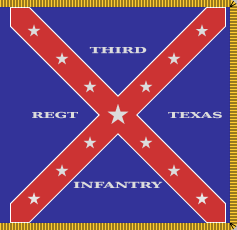
3rd Texas Infantry Flag
|
Third Texas Infantry Battle Flag 1861-1865
Colonel Philip N. Luckett organized the Third Texas Infantry in the summer of 1861. The men of the Third came largely from Central Texas, specifically Bexar, Gillespie, San Patricio, and Travis counties. As these counties were heavily populated with recent German immigrants and persons of Mexican descent, a large number of the regiment's men were foreign-born. The Third Texas Infantry saw little action during the war, suffered from low morale, verged on mutiny, and had a high desertion rate.
The Third was first assigned to the defense of San Antonio (1861-1862), then moved to Brownsville and Galveston in 1863 to protect cotton shipments and guard against raids from Mexico. In 1864, they were moved to the lower Brazos and San Bernard rivers where they apparently spent their time occassionally firing at Union gunboats on the rivers. The regiment only saw one actual battle during the war. During the Red River campaign they fought in the Battle of Jenkins Ferry on April 30, 1864. The following year General Edmund Kirby Smith surrendered the regiment at Galveston, where it was disbanded at the war's end.
Their flag was presented to the Third Texas Infantry by Mrs Phelps of New Orleans, who had it made in Havana. The reversal of blue and red colors on their battle flag is attributed to a misunderstanding of the correct color pattern of the Army of Northern Virginia. Later, several other Confederate battle flags from the Trans-Mississippi Department, also thought to be of Cuban manufacture, displayed the same color reversal. |

California Confederate Flag
|
The J.P. Gillis Flag 1861
During the first year of the Civil War, this flag was captured in Sacramento, California. The creator was a Major J.P. Gillis, who flew the flag on the 4th of July, 1861. Major Gillis claimed he was celebrating the independence of the United States from Britain as well as the southern states from the Union. He unfurled his Confederate flag and proceeded to march down the main street of Sacramento to delight of the onlookers. The flag was of his own design and the canton contains seventeen stars rather than the Confederate's seven.
Because the flag was "captured" by Jack Biderman and Curtis Clark, who were enraged by Gillis' actions, the flag is often also referred to as the "Biderman Flag." Poor Clark, nobody ever refered to the flag as "The Clark Flag," except here.
|
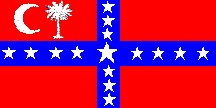
South Carolina Sovereign Flag
|
South Carolina Sovereignty Flag 1860
This is a version of an early flag raised over South Carolina shortly after its secession from the Union in 1860 (it was also supposed to have been raised over Yale University by sympathizers).
It is called the South Carolina Sovereignty Flag and was supposed to have been an inspiration for the Confederate flag in its later form.
|
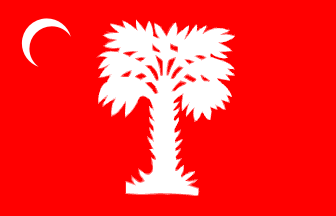
Citadel Battery Flag 1861
Captured in 1865 by the 20th Iowa
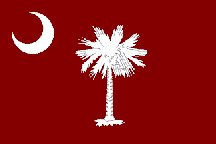
Big Red
Modern version of The Citadel Flag
|
The Citadel Battery Flag 1861
In early 1861, after South Carolina seceded from the United States, her military forces took possession of all military installations around Charleston harbor, except Fort Sumter. One of the smaller installations, or batteries, was manned by cadets from the South Carolina Military Institute, also known as "The Citadel." The flag flown over the battery manned by the Citadel cadets was a red field with a white palmetto and crescent. These cadets had the distinction of having actually fired the first shots in what was to become the Civil War. They fired warning shots at the steamer "Star of the West," which had been despatched by President Buchanan to supply the garrison at Fort Sumter. The "Star of the West" was turned back by the artillery fire. The "Palmetto Battery" continued to serve until April of 1865 when it and its flag was captured at Mobile by the 20th Iowa. The flag remained in the Iowa State Historical Society Museum Collection unrecognized and labeled "Unidentified - Red Palmetto" until its rediscovery in the 1960s. It is now on a long term loan from the Iowa State Historical Society and being displayed at the Citadel and seen daily by the proud students. The original bright red background has faded to dull maroon, and the white Palmetto tree has discolored down to a brownish gold.
A similar red flag with a white palmetto tree and crescent has since been adopted as the unofficial flag of The Citadel Military Institute. It is today affectionately known as "Big Red." For some undocumented reason the crescent on the 1861 Citadel Battery Flag is facing the opposite direction as found on the modern South Carolina State flag and the current Citadel flag. Perhaps this is because South Carolina's present flag is a design that was formulated as a possible national banner when the state seceded from the Union on December 20, 1860, and it had a reversed crescent. Since the firing upon the "Star of the West" took place less than three weeks after the Ordinances of Session were adopted by South Carolina, this may have been caused by a verbal description being misinterpreted before standardization could occur. |
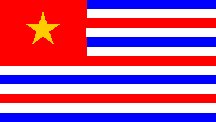
Louisiana Confederate Flag
|
Confederate State of Louisiana Flag 1861-1865
This flag of Louisiana was adopted in 1861. Although it is sometimes referred to as the flag of the Republic of Louisiana, this is not accurate, because this was actually the flag of Louisiana as a Confederate State. Louisiana has always been proud of its Spanish and French heritage. Although the flag is obviously based on the design of the U.S. Flag with a square canton and 13 stripes, the canton is colored red with a single yellow star honoring the colors of the Spanish flag, and the stripes of blue, white, and red honored the colors of the French flag.
|
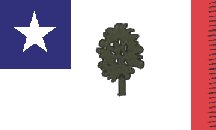
Mississippi Confederate Flag
|
Confederate State of Mississippi Flag 1861-1865
The official flag of Mississippi during the War for Southern Independence was a white flag with a magnolia tree in natural colors. The canton was blue and had a single white star. The fly was a thin red bar extending vertically the length of the flag; sometimes it included red fringe as well. The flag was so popular Mississippi became known as the "Magnolia State." Although possibly originally a mythical or suppositious flag, popular usage has claimed this design and it was used as the state flag until 1894 when the present flag was adopted.
A version of this flag was also said to be used by the 3rd Mississippi Infantry as a regimental flag during the war. However, according to well-known Mississippi flag scholar (Vexillologist) Clay Moss, it was probably adopted after the war as the 3rd Mississippi United Confederate Veterans (UCV) Regimental flag. His research into this particular Magnolia flag is still ongoing.
|
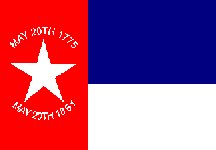
North Carolina Confederate
|
Confederate State of North Carolina Flag 1861-1865
The first ten regiments of North Carolina Volunteer Troops (Later renamed the 11th through 20th North Carolina regiments) received this silk state flag made in Norfolk, Virginia by a private contractor. Later, in 1862, the state provided these regiments wool and cotton versions of the state flag made in Raleigh.
The only other Confederate state that made such an effort to issue state flags, was Virginia. Virginia issued state flags from 1861 into 1865 for her regiments.
|
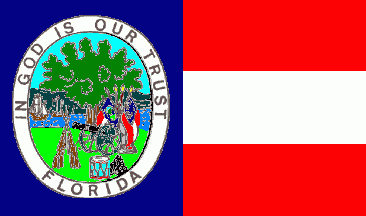
Florida Flag
|
Confederate State of Florida Flag 1861-1865
After Florida seceded from the Union in January 1861, a number of unofficial flags flew over the state. The general assembly passed an act directing Governor Madison Perry to adopt "an appropriate device for a State flag which shall be distinctive in character." Six months later the Governor had the Secretary of State record the description of Florida's first official flag.
Although we only have a written description of this flag, and none survive today, this reconstruction is pretty accurate according to flag scholars and is being reproduced today and in use by various groups.
|

Palmetto Guard Flag
|
Company C, South Carolina 18th Artillery Battalion
Company C was part of the South Carolina 18th Heavy Artillery Battalion, also called the "Siege Train Artillery Battalion" and the "Palmetto Guard," The 18th was organized in 1862 with three companies in Charleston, South Carolina.
The Guard fought at Fort Sumter, Grimball's Landing, Battery Wagner, James Island, and John's Island. In 1864, Company C was transferred to Pegram's Battalion of Artillery of the Army of Northern Virginia and fought its last battle as artillery at the Petersburg. What remained after the Petersburg siege, served as infantry in the Army of Tennessee, which surrendered in April of 1865.
|
- My thanks to Greg Biggs for his expertise and help developing this section -
| Top of Page | Flags of the North on this page | Flags of the South on this page |
| Chart of More Northern Regimental and Unit Flags | Chart of More Southern Regimental and Unit Flags |
| Chart of Irish Regiments and Units (Both North and South) |
|